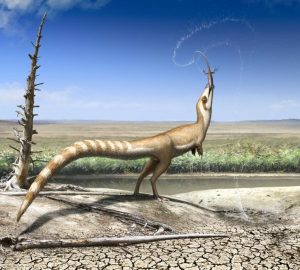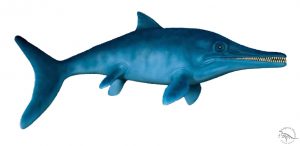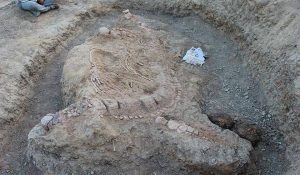The science of paleontology has been a very active and exciting field of research over the past few years and this past month has seen the announcement of several new discoveries. I’ve chosen three items to discuss in today’s post.
The first discovery I’d like to discuss concerns new evidence about the appearance and skin colouration of dinosaurs. Now everybody knows that most of the dinosaur fossils that are found are just the bones of the animals. And you certainly can’t tell what colour a creature was from its bones. Impressions of the skin of dinosaurs are rare and those impressions with traces of skin colour rarer still.
Because of this fact for many years dinosaurs were usually portrayed as having rather bland colouration, normally just a shade of green. The illustration below from Sinclair Oil Company (Their symbol is an Apatasaurus) shows what we thought dinosaurs looked like in the 1950s and 60s. Notice how the animals are all green or gray and even on those with strips the strips are just a different shade of the main colour.

Scientists are a patient bunch however, they kept looking for evidence of soft tissue and there are a lot of fossils out there to find. Over the last twenty years a number of fossil specimens have been found that now tell us a great deal about dinosaur appearance. It turns out that some dinosaurs at least had either vibrant colours or elaborate patterns, or both on their skins, or feathers! Yes, we also now know that many dinosaurs were covered in feathers to keep them warm.
In fact a recent paper published in the journal ‘Current Biology’ describes how small theropod dinosaur from China called Sinosauropteryx, in addition to being feathered was also decked out in alternating dark and light bands similar to the way a raccoon looks. The image below shows what the animal looked like according to co-author Fiann Smithwick of Bristol University.

Doctor Smithwick and his colleagues came to their conclusions after an extensive study of three excellently preserved specimens of Sinosauropteryx. The specimens were not only examined under a microscope but the researchers also used cross-polarized filters to bring out the contrast in the colour patters. The image below shows one of the fossils used in the study as seen under cross-polarized light, the areas of light and dark pigmentation are evident.

This pattern of colouration is known as counter shading and is a common pattern in living animals. Doctor Smithwick suggests that the dark patches around the eyes may have served to reduce glare the same way that athletes today paint a dark stripe under their eyes.
The second news item I’d like to discuss is about the discovery of two-foot long footprints of a predatory dinosaur from Lesotho in southern Africa. While not as large as Tyrannosaurus Rex the theropod that made the footprints came from a much earlier time, the beginning of the Jurassic period about 100 million years before T rex.
According to paleontologist Fabien Knoll of the University of Manchester “Our finding corroborates the hypothesis that theropods reached a great size relatively early in the course of their evolution, but apparently not before the Triassic-Jurassic boundary.” Despite the fact that no remains of the animal have been found so far it is estimated to have been about 10 meters in length and has been given the name Kayentapus ambrokholohali. The picture below shows the footprints of Kayentapus ambrokholohali.

Finally, we don’t often hear about fossil discoveries from India so the discovery of a well preserved specimen of an ichthyosaur certainly deserves a quick mention. For those who don’t know ichthyosaurs were reptile versions of dolphins that lived during the time of the dinosaurs. Returning to the sea their ancestors had left behind these air breathing lizards evolved fins in place of legs and a fish like tail. The image below shows a typical ichthyosaur.

The specimen was discovered near the Indian city of Kutch in the province of Gujarat. According to Guntupalli Prasad of the University of Delhi the 5.5 meter fossil is believed to belong to the ichthyosaur family Ophthalmosauridae and lived between 90 and 165 million years ago. The photo below shows the ichthyosaur fossil as it was being unearthed.

With these and other exciting fossil finds coming to light on a regular basis this is obviously a good time to be a paleontologist.
